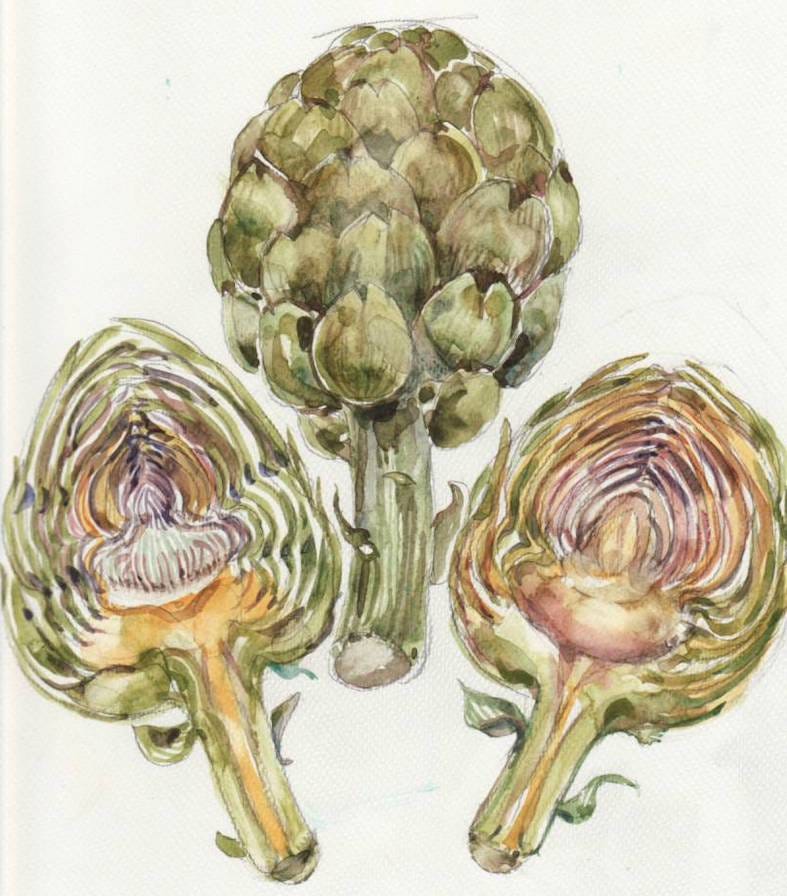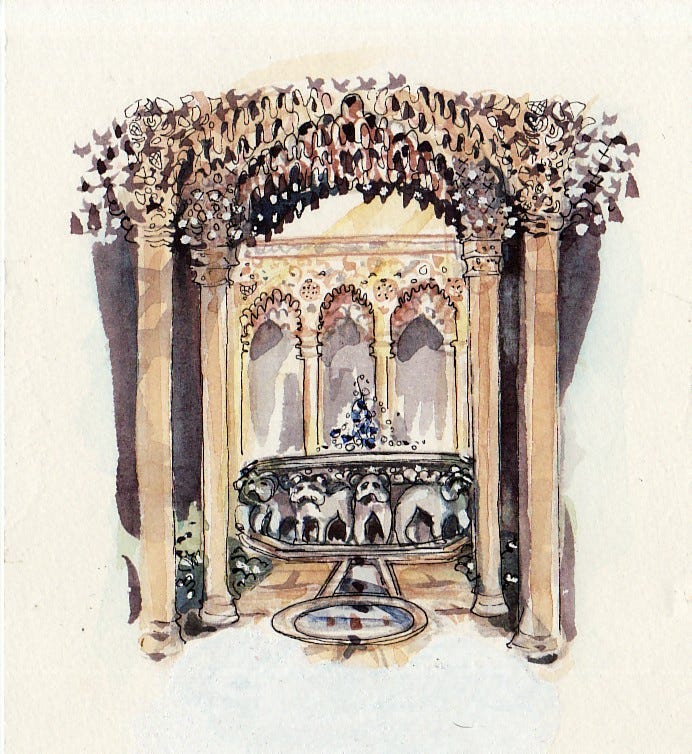Leaf-artichokes, the flower-buds of a member of the thistle family descended from the wild cardoon, Cynara cardunculus, a spectacular blue-flowered native of the Mediterranean littoral. The plant, as with all members of the thistle-tribe, is naturally prickly and tough - characteristics that cannot be entire bred-out in captivity. This explains the attraction of artichoke-hearts sold ready prepared, which is a pity since each separate part - base of leaves, soft innard bracts, tender heart - has its own taste and texture. Such a pleasure is best savoured at leisure in much the same way as other time-consuming culinary tasks - shucking shrimp, picking snails, cracking pistachios.
First to arrive in the markets of the Med (right now) are the little fellows - mature artichokes that don't grow larger than a ping-pong ball - sold in bunches with their edible stalks. Main-crop artichokes are full-grown flower-heads with well-developed chokes - the soft interior heart that forms the base of the stalk and holds the tiny interior florets.
To choose, pick firm, bright, green heads with length of stalk attached and no sign of browning on the leaf-tips. When you get them home, trim off the ends of the stalks and set them in water, as for flowers. To prepare whole, cut the stalk close to the base of the flower (if the stalks are firm and juicy, scrape off the hard outer fibres and add them to the pot). Rub the cut sides with lemon-juice to inhibit browning till you’re ready to cook, or drop the pieces into cold water with a squeeze of lemon.
To cook whole, bring a big pot of salted water to the boil, add the artichokes, return the water to the boil and bubble gently, loosely-lidded, for about 20 minutes, until the outer leaves pull easily from the base. Drain, pass under cold water to halt the cooking process, and set them upside down in a colander to drain. Serve warm or at room-temperature.
Above is a rough sketch of simple dish of fried baby artichokes and wild asparagus served as an anti-pasto at taverna in Puglia known for cucina povera (poor-folks cooking, much appreciated in southern Italy). The artichokes were split in half, including a generous length of stalk, and shallow-fried with a few fresh garlic-slivers. The asparagus shoots were chopped into short lengths like peas, softened in their own juices in a little olive oil, then sharpened and sweetened with a dash of vin coto. No salt was used in the cooking as the red earth of the flat Pugliese plain is already salty from Mediterrean sea-breezes.
To eat your cooked artichoke whole, pull off the outside leaves one by one and dip the tender bases into, say, a simple dressing of olive oil and lemon-juice, or melted butter, or mayonnaise. When you've eaten your way down to the pale dome of inner leaves, pull it off and nibble it round in a single piece. the tips are delicate and tender. Now scrape off and discard the hairy choke to reveal the tender heart, a reward for patience.
To prepare raw artichoke-hearts for stuffing or stewing, trim the stalks close to the base (dice the stalks to include in the stuffing, particularly for rice), snap off the tough outer leaves, slice off the top to within a finger-width of the base, nick out the inner leaf-cone and scrape off the hairy choke with a sharp spoon.
Artichokes have flourished in the sandy soil of the vega, Granada’s ancient floodplain, since the days of the Romans. It was, however, the Caliphs of Al Andaluz, architects of the magnificent gardens of the Alhambra, who built the irrigation channels that bring snow-water from the mountains to keep the market gardens of Granada green and fertile throughout the summer.
Alcachofas granadinas
Artichokes with broad-beans , a combination traditional in Granada, last stronghold of the Moors in Spain, prepared at the beginning of the season, when both artichokes and broad beans, fava, are still young and tender. The inclusion of mint, unusual in Spain, gives finished dish a distinctly North African flavour. If you can find young broad beans in pod, chop whole into short lengths.
Serves 4
8 small artichokes (preferably with stalks)
1 half lemon
500g broad beans
6 tablespoons olive oil
2-3 garlic cloves, chopped
1 large onion, diced small
1 heaped tablespoon diced serrano ham
pinch saffron
1-2 bayleaves
Handful fresh mint-leaves
To finish
2 tablespoons fresh breadcrumbs
1 tablespoon chopped almonds
1/2 teaspoon cumin seeds
First prepare the artichokes. Trim, removing the hard tips of the outer leaves and leaving a generous length of stalk. Slice into quarters and nick out the hairy little choke. Check over the beans and if they look a little on the leathery side, slip them out of their skins.
Warm 4 tablespoons of the oil in a roomy pan, and add the the onion, garlic and quartered artichokes. Season with a little salt and fry gently for about 10 minutes, moving the pieces around as the vegetables soften and gild a little. Add the prepared beans, a generous glass of water and bubble up. Add the ham, saffron, bayleaf and half the mint, roughly chopped. Bubble up again, turn down the heat, lid loosely and leave to simmer for 30-40 minutes till the artichokes are perfectly tender and most of the juices have been absorbed - you may need to add a little more water. Or bake in a moderate oven at 325F/170C/Gas3 for 40-50 minutes.
When you’re ready to serve, fry the breadcrumbs and almonds with in the remaining oil till they begin to brown a little, add the cumin and fry for another minutes and tip over the artichokes and beans. Finish with the remaining mint-leaves
p.s. beloved paid subscribers will shortly be in receipt for fried baby artichokes (Spain) and artichokes with scrambled eggs (Italy). You’ll find more artichoke recipes and my illustrations in The Flavours of Andalucia (Grub Street).
p.p.s. check out my website, elisabethluard.org, for my prints of artichokes and other veg, fruit and flowers (plus some particularly splendid fish).











Being a California native, I grew up eating artichokes -- the endless fields of them in Castroville, south of San Francisco, are a marvel. For those in New England who want to know where to find artichokes free of browned and shriveled leaves, I have found beautiful, fresh big artichokes at Costco, and Trader Joe's carries small artichokes packed in plastic clamshells.
Your mention of the Alhambra in Granada, reminded me of our family trip to Andalucia, when my daughter was studying Arabic in college. We were there, waiting to buy tickets to enter, when she looked up at the Arabic script above the kiosk. It was as if a lightbulb went off for her: "Ohhh. It's not Alhambra. It's AlHammra. There's no letter B. AlHammra means 'the red house.' " Which it is.
I am surprised, Elisabeth, that you say baby artichokes are arriving in the Mediterranean now. Here in Tuscany the artichoke season is well over. It started in March and ended mid May.